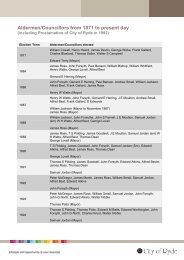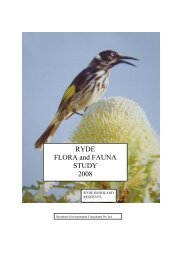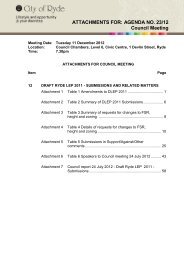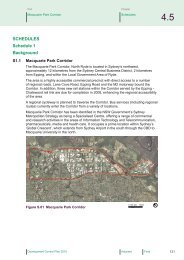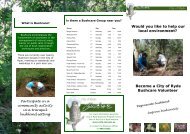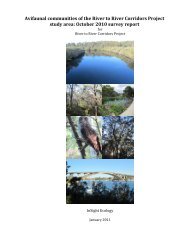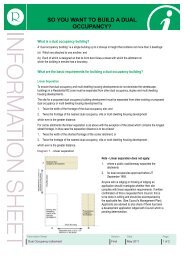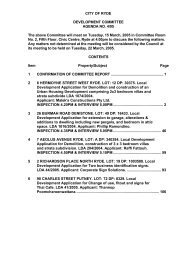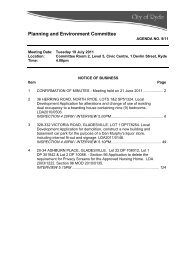RYDE FLORA and FAUNA STUDY 2007 - City of Ryde - NSW ...
RYDE FLORA and FAUNA STUDY 2007 - City of Ryde - NSW ...
RYDE FLORA and FAUNA STUDY 2007 - City of Ryde - NSW ...
You also want an ePaper? Increase the reach of your titles
YUMPU automatically turns print PDFs into web optimized ePapers that Google loves.
3.3 Vegetation Survey Methods<br />
Biosphere Environmental Consultants Pty Ltd<br />
<strong>Ryde</strong> Flora <strong>and</strong> Fauna Survey <strong>2007</strong> 18<br />
The flora study entailed:<br />
1. a general survey <strong>of</strong> the plant species in each reserve<br />
2. quadrat based survey <strong>of</strong> particular bushl<strong>and</strong> areas in each reserve (using 7<br />
stage Braun-Blanquet technique).<br />
Initially, the reserves were explored to compile lists <strong>of</strong> local native plants <strong>and</strong> non-<br />
local native/exotic plant species <strong>and</strong> to assess the vegetation communities. A draft<br />
report Native Plants <strong>of</strong> the <strong>Ryde</strong> District: The Conservation Significance <strong>of</strong> <strong>Ryde</strong>’s<br />
Bushl<strong>and</strong> Plants (Kubiak, 2005) was used as a baseline species list on which to base<br />
observation in this study. Native Species Checklists for Parramatta River, Terrys<br />
Creek, Kittys Creek <strong>and</strong> Buffalo Creek Catchments <strong>and</strong> two quadrats from the Field<br />
<strong>of</strong> Mars Reserve are in Appendix 1. This list has been added to as new observations<br />
have been made during the survey. A Checklist <strong>of</strong> exotic <strong>and</strong> non-local native plants<br />
for those catchments was also compiled (Appendix 2). Species nomenclature follows<br />
The Flora <strong>of</strong> <strong>NSW</strong> (Harden, G (Ed.), 1990-1993).<br />
Vegetation communities were determined by assessing colour aerial photographs<br />
supplied by Council <strong>and</strong> then ground-truthed. Geology <strong>and</strong> soil types were also<br />
determined. It was stipulated by Council that the methods used for this biodiversity<br />
survey were to be the same as used by the National Parks <strong>and</strong> Wildlife Service<br />
(<strong>NSW</strong>). The model for this survey was taken from Tozer (2003). Quadrats were to be<br />
400 m 2 (0.04ha) in area <strong>and</strong> were placed in areas <strong>of</strong> highest diversity <strong>of</strong> local native<br />
plants. In order to assess abundance a Braun-Blanquet scale was used. While this<br />
method involves a subjective or qualitative description, it also provides for a<br />
quantitative or measurable documentation for comparison <strong>of</strong> plant community<br />
characteristics, especially species richness. Therefore, an inventory <strong>of</strong> plant species<br />
<strong>and</strong> approximate species numbers was completed for each quadrat then each species<br />
was assigned a Braun-Blanquet Cover Class. For assessment <strong>of</strong> tree cover the Specht<br />
Vegetation Structure (Table 6.1 (Specht) in Recher, Lunney & Dunn, 1986) is used.<br />
Finally, species contained in the quadrats were compared to species listed in the map<br />
units described by Tozer (2003) for classification purposes. Tozer lists the number <strong>of</strong><br />
native plants <strong>and</strong> the number <strong>of</strong> positive diagnostic native species required to reach a<br />
95% confidence interval in order to fulfill the map unit classification. This<br />
information is provided in the individual quadrat descriptions (See Appendix 3).<br />
The seven point Braun Blanquet Cover Class score (from Tozer, 2003) was assigned<br />
as follows (Table 2):<br />
Table 2<br />
Braun Blanquet Cover Class Scores<br />
Braun Blanquet<br />
Cover Abundance<br />
Cover Class<br />
1 Rare, few individuals (three or less) <strong>and</strong> cover




